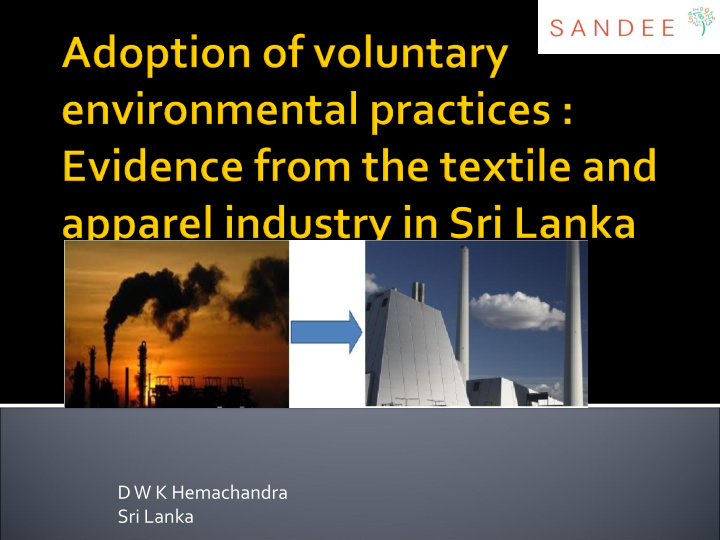



D W K Hemachandra Sri Lanka
What is the industry? 58% of Export income earnings Textile and Apparel Industry in Sri Lanka Significant level of 52% of employment environmental generation (direct) degradation
Recognitions Green factories Lean production processes Market share is guaranteed without GSP+ benefit Followers of carbon footprint Higher price for Sri Lankan apparel
What voluntary 10 Case studies EMPS exist? 55/329 of BOI Why are they registered factories adopted in some surveyed factories? Detailed interviews Policy lessons? Descriptive and statistical analysis
ISO 14001 – 27% 50 48 Material 40 37 reuse – 89% 30 23 20 Water 15 recycling – 42% 10 Environ 0 mental water recycling material re-use Audits – environmental audits ISO 14001-certification 67%
Variables Signifi cance Legislative pressure ? Foreign export +*** No of factories +*** Market pressure? Dyeing factories +*** Factory Washing factories -*** Apparel manufacturing +** characteristics? Availability of ISO 9001 +*** Located in BOI Zone +*
Zonal Fines Facilities and Inspections Staff Local Producer Awareness Consumer on Returns from Awareness EMPS
25% of water bill [Recycle water] > 10% electricity bill [Layout planning, painting, sky lighting, LED bulbs, use of alternative energy sources such as saw dust, coconut, solar, use of improved machines such as solar panels, rice cookers, boilers, A/C, hybrid vehicles] 100% municipal solid waste [Food waste is used for animal feeding and composting] Reuse of cones, fabric cuts, bulbs, paper
K.H. Muthukudaarachchi Deputy Director General Environmental Pollution Control Division Central Environmental Authority
Apex body in Sri Lanka to control Environmental Pollution by setting standards, norms and criteria for the protection of beneficial uses and maintaining the quality of the environment Established under the provision of the National Environmental Act (NEA) No.47 of 1980.
MAJOR TOOLS STANDARDS Environment Protection Water Quality Standards Air Quality Regulations License Noise Regulations Environmental Impact Solid waste management Assessment Vehicle Emission Site Recommendation Regulations procedures Guidelines on Vibration Fines and penalties and Air Blast Over Environmental Pressure Standards & Guidelines
STRENGTHS WEAKNESSES Qualified staff Inadequate staff Frequent training Not enough inspections Sound act Inadequate laboratory facilities Not enough penalties
This study explains different methods of EMPs 3 R concept Energy efficiency mechanisms Benefits of EMPs Reduce cost Reduce waste Attractive business strategy Reasons for such adoption Customer awareness Firms’ strength and targets
Appointment of staff (100 for inspection) Initial steps take to establish laboratory facilities at the provincial level Discussions are going on with the Attorney General (amount of fines)
Recommend
More recommend